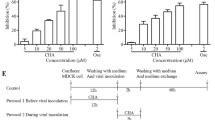Abstract
NAS preparation, a kind of Chinese herbal medicine found by the Yunnan Eco-agricultural Research Institute, has potential antiviral activity. In this paper, the inhibiting effect of NAS preparation on H9N2 subtype Avian influenza virus (AIV) was investigated in vivo. Chickens infected with H9N2 virus were treated with NAS preparation for 4 days. The virus was then detected by hemoagglutination (HA) test and reverse transcription polymerase chain reaction (RT-PCR). The results showed that no H9N2 virus could be detected at the 7th day when the chickens were treated with 0.2g/kg/d or 0.1g/kg/d of NAS preparation. However the virus could be detected in other chickens without NAS preparation treatment. This result suggested that NAS preparation may be a potential drug candidate to control infection of H9N2 subtype AIV in chickens.
Similar content being viewed by others
References
Butt K M, Smith G J D, Chen H, et al. 2005. Human infection with an avian H9N2 influenza A virus in Hong Kong in 2003. J Clin Microbiol, 43 (11): 5760–5767.
Gai J Y. 2003. Test of statistical hypothesis. In: Methods of Experimental Statistics. The first edition. Beijing: The Publishing Company of China Agriculture, p92–96.
Gan M H. 2002. In: Avian Influenza. The second edition. BeiJing: The Publishing Company of China Agriculture, p 181–192.
Guo Y, Wang J. 2006. The new progress of study on arteannuin drugs. Chin J Clin Pharmacol Therap, 11(6): 615–618.(in Chinese)
Huang J R, Liu Y M. 2005. The progress of study on chemical composition and pharmaco-activity of Hedyotic diffusa. Chin Formul Prod, (27): 1329–1332.(in Chinese)
Jiang P, Huang L C. 1995. The studies on cumulative and general toxicity of common stonecrop herb. Liaoning J Trad Chin Med, 22(10): 475–479.(in Chinese)
Johnson C D, Kudsk K A, Fukatsu K, et al. 2003. Route of nutrition influences generation of antibody-forming cells and initial defense to an active viral infection in the upper respiratory tract. Ann Surg, 237(4): 565–573.
Kadir T, Kyosuke N, Avin K, et al. 1996. Antiviral effect of Sanicula europaea L. leaves extract on influenza virus-infected cells. Biochem Biophys Res Commun, 225:22–26.
Katz J M, Lu X H, Tumpey T M, et al. 2000. Molecular correlates of influenza A H5N1 virus pathogenesis in mice. J Virol, 74(22): 10807–10810.
Kyoko S, Stefan H, Masato H, et al. 2004. PB2 amino acid at position 627 affects replicative efficiency, but not cell tropism,of HongKong H5N1 influenza A viruses in mice. Virology, 320: 258–266.
Li C J, Yu K Z, Tian G B, et al. 2005. Evolution of H9N2 influenza viuses from domestic poultry in Mainland China. Virology, 340(1): 70–83.
Long J X, Wang Q Z. 2005. The sequence analysis and all gene cloning of H5N1 subtype Avian Influenza virus(A/duck/Shandong/093/2004). Acta Microbiol Sin, 45(9): 1840–1842.(in Chinese)
Matrosovich M N, Krauss S, Webster R G. 2001. H9N2 influenza A viruses from poultry in Asia have human viruslike receptor specificity. Virology, 281 (2): 156–162.
Peiris M, Yuen K Y, Leung C W, et al. 1999. Human infection with influenza H9N2. Lancet, 354 (9182): 916–917.
Qing F H. 1990. The enhancement properties of Hedyotic diffusa on mice immune functions. Shanghai J Immunol, (16): 32–34. (in Chinese)
Schmidtke M, Schnittler U, Jahn B, et al. 2001. A rapid assay for evaluation of antiviral activity against coxsackie virus B3,influenza virus A,and herpessimples virus type 1. J Virological Methods, 95: 133–143.
Shang R F, Na Z Y, Yang H J, et al. 2008. The Effect of NAS preparation on Killing H5N1 and H9N2 subtype AIV in vitro. J Trad Chin Veter Med, 6:5–7.(in Chinese)
Wang J M, Yan J P. 2003. The progress of study on pharmacologic action of common stonecrop herb. Acta Chin Med Pharmacol, 31(4): 57–59.(in Chinese)
Wang X h, Cui Y, Liang J P, et al. 2005. The general and chronic toxicity test of NAS preparation. J Trad Chin Veter Med, 4:24–25.(in Chinese)
Yin Z, Liu J H. 1997. The laboratory diagnostic techniques of viral diseases. In: Animal Virology, Beijing: Science Press, 291-294.
Zheng H Z. 1997. In: The modern study and application of traditional Chinese medicine. Beijing: Academe publishing company, p221–225.
Zhu X L, Wei X B. 2006. The progress of study on anti-virus Chinese herbal medicine. Chin J Trad Veter Sci, (1): 33–38.(in Chinese)
Author information
Authors and Affiliations
Corresponding author
Additional information
Foundation item: Key Technologies Research and Development Program (2004BA519A26)
Rights and permissions
About this article
Cite this article
Shang, Rf., Liang, Jp., Na, Zy. et al. In vivo inhibition of NAS preparation on H9N2 subtype AIV. Virol. Sin. 25, 145–150 (2010). https://doi.org/10.1007/s12250-010-3082-8
Received:
Accepted:
Published:
Issue Date:
DOI: https://doi.org/10.1007/s12250-010-3082-8




